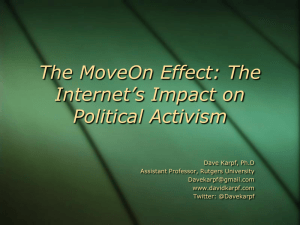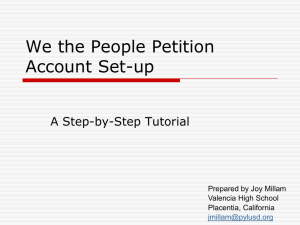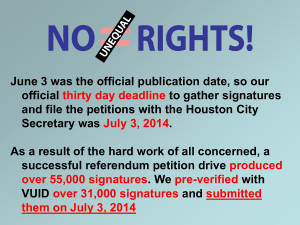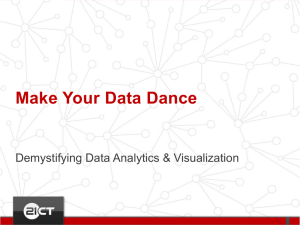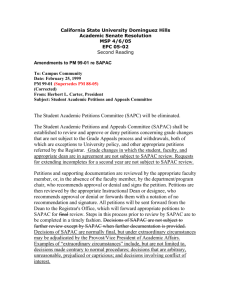Karpfpresentation
advertisement
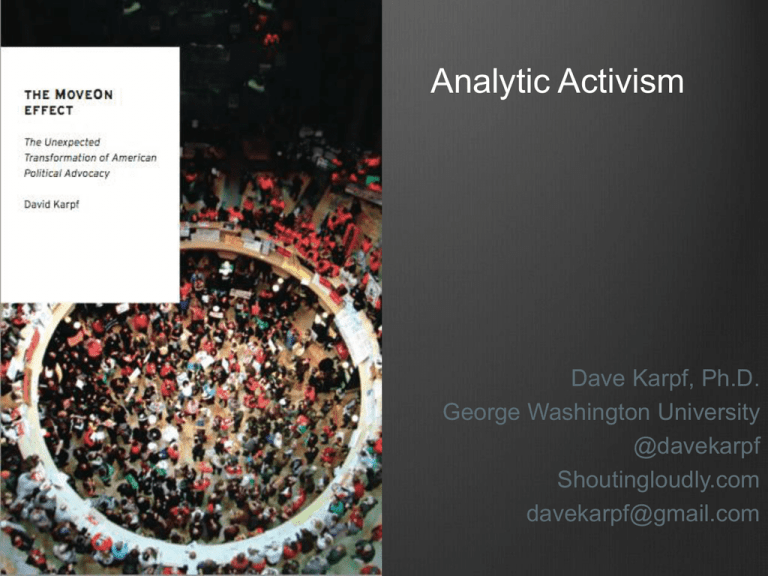
Analytic Activism Dave Karpf, Ph.D. George Washington University @davekarpf Shoutingloudly.com davekarpf@gmail.com I’m going to try to cover a lot of ground in this talk Main findings from The MoveOn Effect (2012) Major findings from Analytic Activism (2015 or 2016) Early findings from The New Infrastructure of Cross-National Activism (2017? 2043? Who knows.) (…Yes, I’m writing a trilogy. And yes, that’s a little weird.) Current scholarship tends to highlight examples of “bottom-up” or “organizationless” political activism. The Main Theoretical Takeaways 1. The digital age features organizing with different organizations, not organization-less organizing. 1. Rather than focusing on how disorganized masses use the internet to speak, we ought to pay attention to how organized interests use the internet to listen. 2. The focus on organized listening points us toward different research objects, which remain obscure in the rush to embrace “big data.” The MoveOn Effect Rather than focusing on individual digital tactics (e-petitions) or digital platforms (YouTube, Twitter), I focus on the “organizational layer” of American politics. Major differences in membership and fundraising regimes, which in turn influence organizational structure, leadership styles, and preferred strategies and tactics. Disruptive implications for existing organizations. Partisan dynamics/Outparty Innovation Incentives. A Generation Shift at the Organizational Layer of American Politics Imagine the membership affiliations of a college-aged activist today. Membership is an organizational construct: This has all happened before Skocpol (2003) describes the displacement of cross-class membership federations by professionally-managed advocacy groups. Membership went from attending/participating to supporting/check-writing This was a technologicallymediated transition. And we’re experiencing another one (Bimber 2003) Membership: Sedimentary organizations • Waves of mass mobilization leave behind sedimentary member lists • Those lists become organizations • New orgs focus attention on the issues dominating the media agenda, rather than staying within an issue silo. • Resultant shift in issue choice, tactics, mobilization campaigns. 3 Elements of the Netroots Fundraising Model 1. Zero-(marginal) cost scaling. 100 e-mails cost the same as 10,000 e-mails. 2. “A/B Testing.” • (sometimes) A form of passive democratic input • (sometimes) A form of tactical optimization 1. “Headline Chasing.” Targeted Appeals, Timely Issues. Note: this is all small-donor fundraising. Many TNGOs rely on corporations, foundations, patron donors, and government grants instead. Fundraising Styles SaveOurEnvironment.org “We have less than 48 hours to reach our goal of raising $10,000 by 11:59PM on December 31 – and we’re not there yet There are lots of reasons why you should give to SaveOurEnvironment.org right now: First, because we’re counting on you. [...] Second, because the year is coming to a close. [...] And third, because there is no time like the present. The time for excuses is over: America needs MoveOn.Org “Dear MoveOn member, You’ve probably heard about how Wall Street financier Bernard Madoff scammed investors out of at least $50 billion. But you may not have heard that his victims included the foundations that support some really important progressive organizations. Groups that fight for human rights, fair elections and racial justice are getting hit hard - just in time for the holidays. We’ve worked side-by-side with many of them. If these groups can’t replace the funding that came from investment accounts that Madoff stole, they may be forced to start cutting important projects or, in some cases, even lay off staff. Can you pitch in Generation Gap Questions? This netroots model is now global in scale. OPEN’s Core Organizations MoveOn.org (US) – 8 million members (2.5% of national population) Campact (Ger) – 1 million members (1.25% of national population) GetUp (Aus) – 640,000 members (2.7% of national population) 38 Degrees (UK) – 2.7 million members (4.2% of national population) Leadnow (Can) – 360,000 members (1% of population Meanwhile Change.org has 79 million members in 196 countries, and Avaaz.org has 39 million members globally. 21st Century Consumer Organizing 5 million members since 2011 Global in scope All corporate campaigns Zero traditional boycotts. Analytic Activism Two Classes of Analytics Tactical Optimization From simple (A/B) to complex (Field Experiments). Performance improvement of existing mobilization and persuasion efforts. Passive Democratic Feedback From simple (A/B) to complex (mass sentiment analysis) Strategic directionsetting/agenda-setting Slight governance input through computational management (Kreiss 2012) Substantial governance input – new form of quantified public opinion. Primary applications have been electoral. Primary applications have been non-electoral. Tactical Optimization Is Now Well-Known But there’s more to analytics than simple fundraising optimization. Passive Democratic Feedback Affects Tough Strategic Choices Analytics also supports a broader “culture of testing.” Key Limitation: The Analytics Floor Analytics becomes increasingly useful as your supporter list grows. (think KKV) The analytics floor is the practical threshold below which analytics cannot be effectively used. Particularly important for day-to-day computational management Less important for tactical optimization if lessons are shared within-sector. Gives rise to new industries of service-providers. Some help analyze results (optimize.ly, shareprogress), others help build lists (change.org). And that brings us to“social petition sites” Social petitions appear to be a classic case of disorganized “connective action” But social petitioning is also big business, governed by multiple, competing (organizational) logics. (for-profit) (nonprofit) Change.org’s petition engine MoveOn Effect 2: Electric Boogaloo Triggering Media Event Staff Create a Strategy, Craft an Email. Weekly Member Surveys Gauge Interest. A/B Testing Refines the Tactics and Messaging. Either Engage Members in Higher-Level Tactics or Pivot to a Different Issue. MoveOn Strategy 1.0 Triggering Media EVent Members Create Petitions, Member Surveys and Petition Signatures Gauge Interest. Staff Leverage Top Petitions, Coach Members and Refine Tactics. A/B Testing Refines the Tactics and Messaging. MoveOn Strategy 2.0 Either Engage Members in Higher-Level Tactics or Pivot to a Different Issue. What I Did Data collection & content analysis Top 10 “featured” petitions at Change.org and MoveOn Petitions 6 months of data (November 2013-May 2014), collected daily 269 distinct petitions appeared at MoveOn, 283 at Change.org Coded for petition rank, author, organizational affiliation, topic area, target, and total petitions. How often do petitions on the two sites overlap? In six months, only six issues were featured with petitions at both sites. 1. Shawn Carter aka Jay Z: End all partnerships with Barneys New York 2. Tell Russia to Release Greenpeace Activists 3. Students at Eastside Catholic School stand up for fired Vice Principal 4. Stop the George Zimmerman Celebrity Boxing Match 5. Veto SB 1062: Arizona’s bill legalizing discrimination 6. Dueling Duck Dynasty Petitions. What is the topical breakdown of the petitions featured on each site? Issue Breakdown Change.org MoveOn 48 47 41 37 35 33 24 21 21 15 9 3 1 0 7 0 1 4 3 17 14 16 15 5 8 32 1 7 4 0 3 1 0 12 6 3 4 0 3 10 9 8 4 0 9 67 0 5 11 10 2 3 5 6 RQ3: Who are the targets of these petitions? Petition Targets Change.org MoveOn 155 131 76 61 46 43 23 11 state/local National-State 4 2 0 national international corporate 0 no target Who are the petition-creators? Petition Authors Organization-Sponsored No Organization 208 150 119 75 Change.org MoveOn How many signatures does the average petition receive? Signatures/Petition Box-and-Whiskers 1000000 100000 10000 1000 100 Change.org MoveOn Social Petition Sites Are Promoting Very Different Types of Politics Change.org produces huge petition signatures around personal stories. But it avoids the most prominent political issues of the day. And the big numbers support a “reverse mullet” business model. What looks like spontaneous citizen campaigning is actually a sophisticated, analytics-informed business plan. MoveOn.org produces moderate petition signatures around prominent political issues. And those signatures help swell the membership rolls of allied organizations, while providing signals of MoveOn member interest. What looks like “clicktivism” is actually the first step in a longerterm plan to build grassroots power. In summary Digitally-enabled social movements still feature a lot of organizations. These organizations face traditional challenges (fundraising, public education, mobilizing long-term power), but have invented new techniques for meeting them (analytics and the culture of testing). When we look for digital footprints in the most obvious places (twitter, web pages), these organizational routines are invisible. So we need to study digital NGOs using a combination of very new and very old research methods. Questions?
